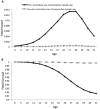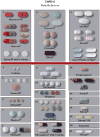Nonmedical Prescription Opioid Use in Childhood and Early Adolescence Predicts Transitions to Heroin Use in Young Adulthood: A National Study - PubMed (original) (raw)
Nonmedical Prescription Opioid Use in Childhood and Early Adolescence Predicts Transitions to Heroin Use in Young Adulthood: A National Study
Magdalena Cerdá et al. J Pediatr. 2015 Sep.
Abstract
Objectives: To examine the relationship between nonmedical use of prescription opioids and heroin initiation from childhood to young adulthood, and to test whether certain ages, racial/ethnic, and income groups were at higher risk for this transition.
Study design: Among a nationally representative sample of US adolescents assessed in the 2004-2011 National Surveys on Drug Use and Health cross-sectional surveys (n = 223,534 respondents aged 12-21 years), discrete-time hazard models were used to estimate the age-specific hazards of heroin initiation associated with prior history of nonmedical use of prescription opioids. Interactions were estimated between prior history of nonmedical use of prescription opioids and age of nonmedical use of prescription opioid initiation, race/ethnicity, and income.
Results: A prior history of nonmedical use of prescription opioids was strongly associated with heroin initiation (hazard ratio 13.12, 95% CI 10.73, 16.04). Those initiating nonmedical use of prescription opioids at ages 10-12 years had the highest risk of transitioning to heroin use; the association did not vary by race/ethnicity or income group.
Conclusions: Prior use of nonmedical use of prescription opioids is a strong predictor of heroin use onset in adolescence and young adulthood, regardless of the user's race/ethnicity or income group. Primary prevention of nonmedical use of prescription opioids in late childhood may prevent the onset of more severe types of drug use such as heroin at later ages. Moreover, because the peak period of heroin initiation occurs at ages 17-18 years, secondary efforts to prevent heroin use may be most effective if they focus on young adolescents who already initiated nonmedical use of prescription opioids.
Copyright © 2015. Published by Elsevier Inc.
Conflict of interest statement
The other authors declare no conflicts of interest.
Figures
Figure 1
Fitted probability of A, heroin initiation and B, survival by prior nonmedical prescription opioid use among adolescents and young adults, NSDUH (2004-2001).
Figure 2
Fitted HRs of heroin initiation associated with prior nonmedical prescription opioid use, by age of nonmedical prescription opioid use initiation (NSDUH, 2004-2011).
Comment in
- Acknowledging Heroin Dependence as a Preventable Pediatric Chronic Medical Condition.
Hsiao RC, Walker LR. Hsiao RC, et al. J Pediatr. 2015 Sep;167(3):509-11. doi: 10.1016/j.jpeds.2015.06.027. Epub 2015 Jul 7. J Pediatr. 2015. PMID: 26163081 No abstract available.
Similar articles
- Nonmedical opioid use and heroin use in a nationally representative sample of us high school seniors.
Palamar JJ, Shearston JA, Dawson EW, Mateu-Gelabert P, Ompad DC. Palamar JJ, et al. Drug Alcohol Depend. 2016 Jan 1;158:132-8. doi: 10.1016/j.drugalcdep.2015.11.005. Epub 2015 Nov 21. Drug Alcohol Depend. 2016. PMID: 26653341 Free PMC article. - Heroin use and heroin use risk behaviors among nonmedical users of prescription opioid pain relievers - United States, 2002-2004 and 2008-2010.
Jones CM. Jones CM. Drug Alcohol Depend. 2013 Sep 1;132(1-2):95-100. doi: 10.1016/j.drugalcdep.2013.01.007. Epub 2013 Feb 12. Drug Alcohol Depend. 2013. PMID: 23410617 - Factors associated with nonmedical use of prescription opioids among heroin-abusing research volunteers.
Steinmiller CL, Greenwald M. Steinmiller CL, et al. Exp Clin Psychopharmacol. 2007 Oct;15(5):492-500. doi: 10.1037/1064-1297.15.5.492. Exp Clin Psychopharmacol. 2007. PMID: 17924783 - The burden of the nonmedical use of prescription opioid analgesics.
Gilson AM, Kreis PG. Gilson AM, et al. Pain Med. 2009 Jul;10 Suppl 2:S89-100. doi: 10.1111/j.1526-4637.2009.00668.x. Pain Med. 2009. PMID: 19691688 Review. - Nonmedical use of prescription opioids: motive and ubiquity issues.
Zacny JP, Lichtor SA. Zacny JP, et al. J Pain. 2008 Jun;9(6):473-86. doi: 10.1016/j.jpain.2007.12.008. Epub 2008 Mar 14. J Pain. 2008. PMID: 18342577 Free PMC article. Review.
Cited by
- Racial/ethnic differences in trends in heroin use and heroin-related risk behaviors among nonmedical prescription opioid users.
Martins SS, Santaella-Tenorio J, Marshall BD, Maldonado A, Cerdá M. Martins SS, et al. Drug Alcohol Depend. 2015 Jun 1;151:278-83. doi: 10.1016/j.drugalcdep.2015.03.020. Epub 2015 Apr 2. Drug Alcohol Depend. 2015. PMID: 25869542 Free PMC article. - Longitudinal trends in nonmedical prescription opioid use in a cohort of rural Appalachian people who use drugs.
Havens JR, Knudsen HK, Young AM, Lofwall MR, Walsh SL. Havens JR, et al. Prev Med. 2020 Nov;140:106194. doi: 10.1016/j.ypmed.2020.106194. Epub 2020 Jul 9. Prev Med. 2020. PMID: 32652132 Free PMC article. - Association of Prescription Drug Monitoring Programs With Opioid Prescribing and Overdose in Adolescents and Young Adults.
Toce MS, Michelson KA, Hudgins JD, Hadland SE, Olson KL, Monuteaux MC, Bourgeois FT. Toce MS, et al. Ann Emerg Med. 2023 Apr;81(4):429-437. doi: 10.1016/j.annemergmed.2022.11.003. Epub 2023 Jan 18. Ann Emerg Med. 2023. PMID: 36669914 Free PMC article. - Association of Opioid Prescribing Patterns With Prescription Opioid Overdose in Adolescents and Young Adults.
Chua KP, Brummett CM, Conti RM, Bohnert A. Chua KP, et al. JAMA Pediatr. 2020 Feb 1;174(2):141-148. doi: 10.1001/jamapediatrics.2019.4878. JAMA Pediatr. 2020. PMID: 31841589 Free PMC article. - Prevalence and Risk Factors of Nonmedical Prescription Opioid Use Among Transgender Girls and Young Women.
Restar AJ, Jin H, Ogunbajo A, Goedel WC, Millett G, Sherwood J, Kuhns L, Reisner SL, Garofalo R, Mimiaga MJ. Restar AJ, et al. JAMA Netw Open. 2020 Mar 2;3(3):e201015. doi: 10.1001/jamanetworkopen.2020.1015. JAMA Netw Open. 2020. PMID: 32176305 Free PMC article. Clinical Trial.
References
- SAMHSA. NSDUH Series H-48, HHS Publication No (SMA) 14–4863. Rockville, MD: Substance Abuse and Mental Health Services Administration; 2014. Results from the 2013 National Survey on Drug Use and Health: Summary of National Findings.
- SAMHSA. NSDUH Series H-44, HHS Publication No (SMA) 12–4713. Rockville, MD: Substance Abuse and Mental Health Services Administration; 2012. Results from the 2011 National Survey on Drug Use and Health: Summary of National Findings.
Publication types
MeSH terms
Substances
Grants and funding
- T32DA031099-01A1/DA/NIDA NIH HHS/United States
- R03 DA037770/DA/NIDA NIH HHS/United States
- K01 DA030449/DA/NIDA NIH HHS/United States
- R03DA037770/DA/NIDA NIH HHS/United States
- T32 DA031099/DA/NIDA NIH HHS/United States
- R03 DA023434/DA/NIDA NIH HHS/United States
- K01DA030449/DA/NIDA NIH HHS/United States
- R01 DA037866/DA/NIDA NIH HHS/United States
- HD020667/HD/NICHD NIH HHS/United States
- DA023434/DA/NIDA NIH HHS/United States
LinkOut - more resources
Full Text Sources
Other Literature Sources
Medical


